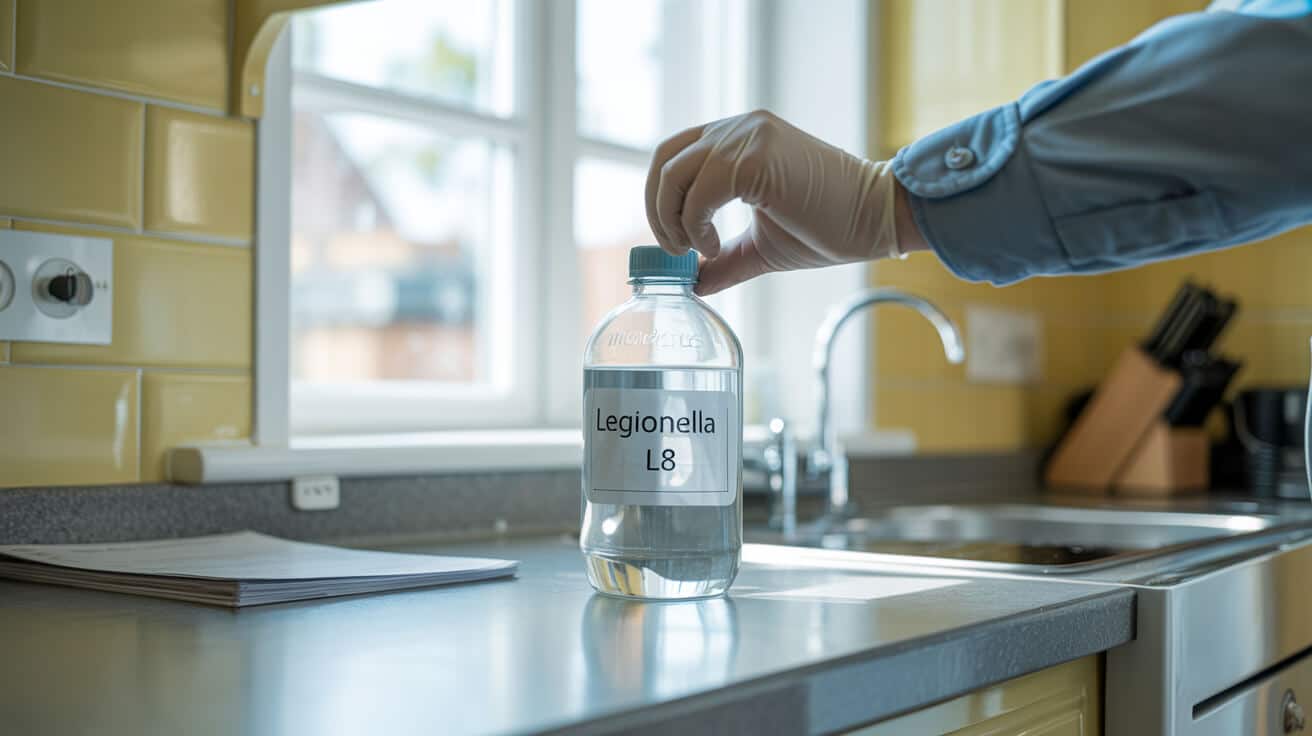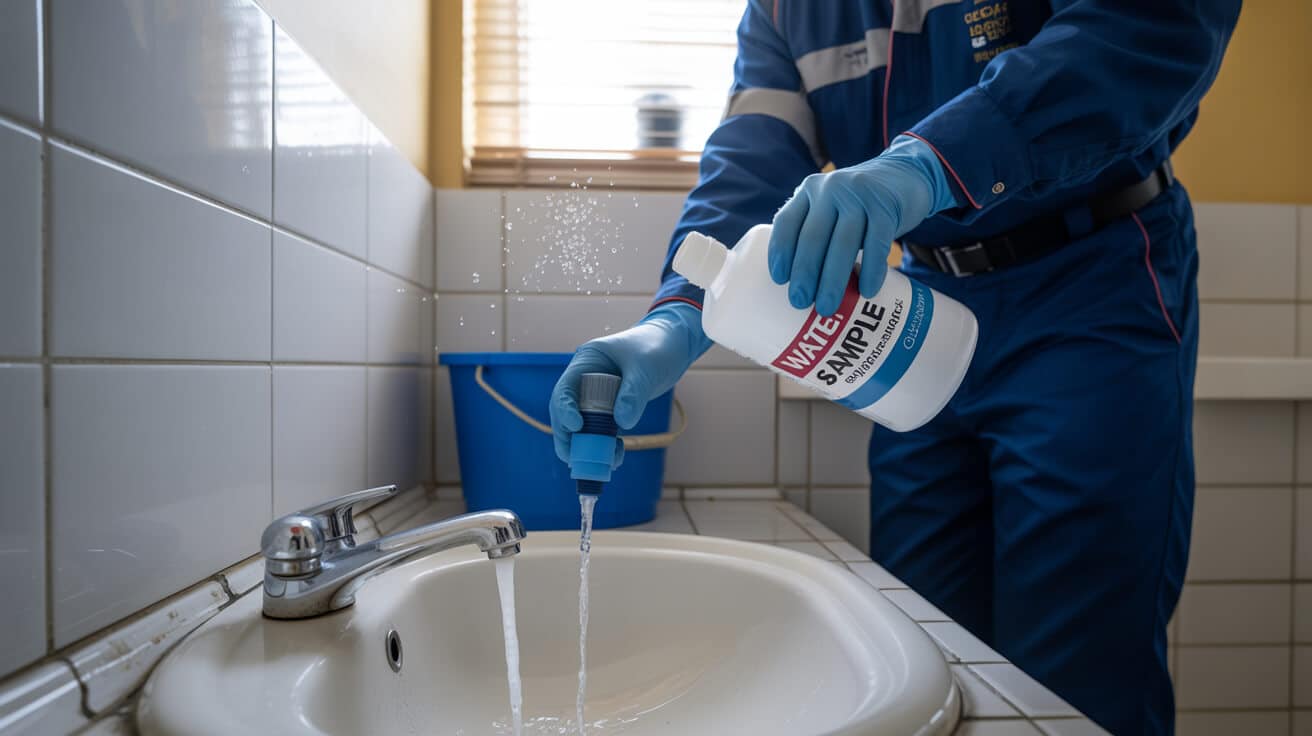 Legionella Control & L8 Compliance For Landlords And Businesses
Legionella Control & L8 Compliance For Landlords And Businesses

Why Is Legionella Control & L8 Compliance a Non-Negotiable Standard for Landlords and Businesses?
Legionella isn’t just “a problem for old buildings” or a tabloid scare—it’s a real risk hiding in the background of everyday properties, big or small, new or old. Any system where water can sit or stagnate—think underused flats, closed-off floor spaces in offices, or even a forgotten tap in a shop kitchen—creates fertile ground for Legionella bacteria. For landlords and businesses, ignoring this risk is more than an operational oversight. It’s an open invitation to legal, financial, and reputational consequences you only notice when it’s already too late.
Most compliance failures creep up quietly—by the time you notice, the damage and cost are real.
UK regulations pull no punches. Whether you rent out a single property or manage an estate of offices, keeping your water systems in check is now law—backed by Health and Safety Executive (HSE) enforcement, local authority interventions, and tight insurance scrutiny. It’s not just about preparing a policy and shelving it. Today, you must show active, ongoing control and up-to-date documentation. For property stakeholders looking to future-proof their assets, this is where All Services 4U provides not just routine checks but strategic solutions built for audit-proof reliability across all sectors.
How Do Routine Legionella Risks Become Mandatory Legal Responsibilities?

The Legionella threat isn’t always obvious, and that’s the problem. Bacteria thrive in stagnant water found in overlooked parts of plumbing, underused showers, little-used outlet taps, and old pipework—even in freshly-refurbished buildings left empty during transitions. The invisible nature of Legionella is why UK law spells out your responsibility in black and white: if you control, own, or are responsible for a workplace, rented flat, or managed block with water systems, you are legally required to assess, control, and log Legionella risks—no exceptions for small landlords or big agencies.
Water you don’t check is risk you can’t manage. Legionella multiplies silently wherever activity drops or vigilance fades.
The HSE sets a clear expectation: every property requires a named dutyholder, a recent risk assessment, and real, accessible records that stand up in an audit (HSE). Miss a single assessment, fall behind on record-keeping, or drop the wrong paperwork, and you face real consequences—civil claims, insurance refusal, and potentially hefty fines. It’s not about scare tactics; it’s about the proven chain that follows lapses or illness outbreaks. Once something goes wrong, reactive explanations won’t hold water. Only clear evidence of compliance shields you.
Pinpointing the Common Blind Spots in Properties
Even well-intentioned managers and owners miss hidden Legionella incubators:
- Cold water tanks never checked or disinfected
- Disconnected or rarely used outlets, especially after tenant turnover or renovations
- Dead legs in plumbing—old branches left after upgrades, storing stagnant water
- Properties left unoccupied (voids), spaces with irregular use (like gyms and hotels), or outbuildings
- Unmaintained thermostatic mixing valves and systems left on fixed low-usage regimes
What breeds risk is rarely the stuff you can see at a glance—it’s the overlooked and unlogged details that come back to bite.
No matter how modern your building, one period of inactivity or a “lost” record can break your compliance chain. Landlords and dutyholders inherit this liability in full—expecting staff, tenants, or agents to fill the gap is legally and morally unsound.
Is It Enough to Write a Policy, or Do You Need a Living Compliance Process?
Having a policy sitting in a digital folder is not protection—courts and insurers demand living proof of routine control. That means:
- Explicit assignment of dutyholder responsibility, with authority to act
- detailed and current risk assessments for every property (not just “one size fits all” forms)
- Verifiable logs of all cleaning, flushing, and temperature reading tasks, in a system ready for instant review
- Clear annual and event-triggered reviews—so change or incidents aren’t missed
If an outbreak happens, or if a check is triggered, “good intent” doesn’t reduce penalties—only hard evidence stands between you and the stairwell of fines, repairs, or even prosecution.
What Makes ACOP L8 the Bedrock for Legionella Compliance (Not Just “Best Practice”)?

A lot of regulation speaks in generalities. ACOP L8, issued by the HSE, is different: it turns legal duty into specific, minimum, practical steps. When something goes wrong, L8 is the yardstick by which your compliance is judged. If your approach doesn’t precisely align with ACOP L8—every asset, every record, every review—you take on all the legal and financial risk.
Almost compliant isn’t compliant. Every detail matters when your legal and reputational protection is at stake.
ACOP L8 isn’t just “HSE guidance”—it’s an industry-wide baseline that’s enforced as if it were muscular law. In an environment where tenant lawsuits, insurance claim rejections, and local authority fines all reference L8, anything short of full adherence is an expensive gamble.
The Five Pillars of Bulletproof Legionella Control
- Dutyholder Defined, Trained, and Documented
- Name a responsible person for each asset or building, with written training and delegated authority.
- Comprehensive, Evidence-Based Risk Assessments
- Go beyond tick-boxing. Review every outlet, tank, shower, and dead leg; record risks in a traceable, property-specific fashion.
- Actionable, Written Control Routines
- Spell out who handles each control (flushing, cleaning, recording), mapped against time and usage scenarios.
- Live, Recoverable Record Storage
- Keep all records immediately accessible—digital or hyper-organised physical files—for no less than five years.
- Triggered and Annual Reviews
- Schedule annual reviews, but update immediately in response to significant change: new tenants, voids, works, or any illness.
The audit-proof operator isn’t the one who never has a problem—it’s the one who always has a process that stands up to scrutiny.
How to Spot When Immediate Action Is Needed
You can’t simply “set and forget” compliance. Trigger points for an immediate review or surge in controls include:
- Any change in occupancy: new tenants, voids, refurbishment periods
- Modifications to the water system: heating, pipe layouts, or new fixtures
- Reports of illness or suspected water-borne disease, even without confirmation
- Findings in recent audits or self-assessments pointing to lapses
When these arise, compliance isn’t about annual checklists but live adaptation: immediate, documented action keeps you both legal and safe (Arnold Inventories).
What Real-World Risks and Costs Come with Legionella Non-Compliance?

Illness from Legionella can be deadly—especially to vulnerable or immunosuppressed tenants and visitors. Public Health England listed several property-linked outbreaks in the last ten years, often triggered by recent void periods, forgotten outlets, or missing records. But even with no illness, the financial and reputational hits are substantial:
It’s not the outbreak that does most of the damage—it’s the investigation and loss of trust that compound the cost.
Here’s what landlords and businesses actually face:
- HSE-mandated shutdown of water systems or entire buildings, sometimes with days’ notice
- Forced relocation of tenants, rapid remediation bills, and legal defence costs
- Rejection of insurance claims due to paperwork or process lapses
- Negative media, local authority scrutiny, public “blacklist” listings, and valuation reductions
Premium tenants, blue-chip occupiers, and aligned facilities managers now scrutinise compliance records at every handover or negotiation. If your operation runs on paper folders and guesswork, you wear a visible risk tag that suppresses both rent and asset value.
Why Smart Compliance Translates to Tangible Value
Best-in-class compliance isn’t a sunk cost—it’s a business asset. The property owners embracing strict, audit-ready Legionella protocols consistently outperform:
- Retain tenants longer, especially in regulated and corporate markets
- Pay lower insurance premiums—costs frequently cut by 10–25% with digital-log evidence
- Simplify property sales and refinancing, thanks to transparent, current documentation
In sum, strong Legionella management builds trust, closes deals, and becomes a selling point for your asset and organisation.
What Actionable Steps Make Legionella Compliance Bulletproof?

Compliance doesn’t thrive on general good intentions—it lives in clear, actionable steps:
1. Survey and Map Every Water System
Create an inventory for every asset (taps, tanks, showers, pipe runs), especially in shared spaces, voids, or rarely-used outlets. Visual plans support ongoing logbooks and future audits.
2. Commission (and Routinely Update) Risk Assessments
- For single flats or basic setups, self-assessment is possible but still needs documentation
- Multi-unit or commercial properties are safest with City & Guilds qualified, third-party professionals—insurance demands it
- Ensure assessments measure temperature targets (hot above 60°C, cold below 20°C) and identify dead legs or limescale risks
DIY logs are better than nothing, but when an incident arises, only accredited and up-to-date records satisfy insurers or regulators ([Premium Assessments](https://www.premiumassessments.co.uk/legionella)).
3. Implement Reliable, Durable Record-Keeping
- Digital systems are ideal, but meticulously organised paper files still outrank scattered or ad hoc notes
- Every flushing, clean, or temperature check: log it, time-stamp it, and file for at least five years
4. Assign, Delegate, and Track Routine Actions
- Set clear routines: weekly flushes, frequency increases for low-usage outlets, scheduled descaling, and thermometer checks
- Assign, track, and periodically review responsibilities—avoid “somebody handles it” ambiguity
5. Prepare an Emergency-Ready Protocol
- If Legionella is suspected: have a communication plan, instant access to compliance evidence, and a ready investigator or responder
Properties with these layers rarely face costly surprises. Even when the unexpected happens, a live process of logging, adaptation, and response keeps your organisation in control.
Can Good Compliance Actually Drive Savings and Asset Value Instead of Just Consuming Resources?

On the ground, compliance investment is clear—and with current digitisation, costs have fallen. See the table below for typical risk assessment pricing in the UK:
| Assessment Type | Typical Cost | Suitable For |
|---|---|---|
| Single flat, low risk | £55–£140 | Private landlords |
| Large property/portfolio | £140–£500+ | Enterprises, portfolios |
For most, a fixed-fee, accredited assessment is not only market standard—it’s also the document insurers and property networks require.
Routine compliance makes cost-benefit sense. The cost of a single fine or tenant claim can erase years of “savings” from skippering on the basics. Bundled contracts and digital tools have made predictable pricing and automated reminders—once the realm of big landlords—accessible for all. Smart property owners now employ bundled digital compliance support to:
- Cut costs through scale—one service partner, one bill, one portal
- Automate routine checks, lowering the risk of manual error
- Provide tenants, letting agents, and buyers with instant “audit trail” access on request
Being ahead on compliance isn’t expensive—it’s the most reliable way to control unwanted costs and asset risk.
How Do Digital Tools Transform Legionella Compliance from Chore to Leadership Standard?

Paper logbooks and spreadsheet routines introduce weak links—lost paperwork, ambiguous audits, or simple human error. That’s yesterday’s game. Today, leading landlords and facilities managers operate on digital compliance platforms:
- Cloud-driven logbooks mean reminders can’t be missed, logs aren’t lost, and every stakeholder (owners, agents, tenants, auditors) gets real-time access
- Internet-enabled temperature probes and system monitors log readings automatically—no room for “I forgot” or “the note is on another device”
- Compliance dashboard links evidence to repair, asset, and cleaning tasks—embedding water safety into broader property health
All Services 4U delivers tools that fit seamlessly alongside agents’ or managers’ existing dashboards, turning compliance into a live, ongoing process. This approach powers up your audit resilience—no more scanning drawers for missing paperwork, no more last-minute scrambles during inspections.
For digital-first landlords, inspection times halve, disputes evaporate, and their reputation rises within the tenant and property management community.
The move to digital doesn’t just protect you—it signals to clients, investors, and authorities that you’re running a world-class operation.
What Makes All Services 4U the Trusted Engine for Audit-Ready L8 & Legionella Compliance?

Legionella management isn’t a check-box job. All Services 4U’s approach is built for the complexity, pace, and scrutiny of real properties—not just the bare minimum.
Here’s what sets All Services 4U apart:
- Individual L8 risk assessments for every asset: —no off-the-shelf generalisations
- Paperless, instant-access record-keeping: —digital logbooks sync with current workflows, so all records are always ready for audit
- Whole-task coverage: —from flushing and cleaning to annual assessment and emergency response, all in one contract, with no “grey areas”
- Handholding and proactive alerts: —onboarding is managed for you, reminders are automated, support is a call or click away
Landlords and businesses using All Services 4U move from stacks of outdated logbooks to live, hassle-free compliance, with zero paperwork anxiety and higher insurance acceptance rates ([All Services 4U](https://allservices4u.co.uk/)).
This isn’t theory—professional and portfolio landlords, agents, and blue-chip tenants return precisely because strong compliance minimises headaches, raises asset value, and eliminates risk at every turn.
Why Is Effortless Legionella Compliance Now the Baseline for Property Leaders?
The market now expects compliance not as a defensive afterthought, but as a proactive marker of quality. Owners who ignore this reality risk more than a slap on the wrist; they risk lasting financial and reputational damage that outlives any single tenancy.
Winning at Legionella management is about joining the top tier: lowering portfolio risk, attracting better clients, and keeping insurance on side, all while future-proofing your organisation.
Don’t let a missing record or vague process threaten your asset, tenants, or reputation. Take Legionella compliance out of the “unknown.” Connect with All Services 4U for a tailored, audit-ready plan—built by the professionals committed to keeping your property safe, your compliance watertight, and your peace of mind absolute.
Strong compliance doesn’t just protect your property—it defines your leadership. When the next audit or challenge comes, you’ll be ready, not scrambling.
Frequently Asked Questions
What unique legal obligations do UK landlords and facilities managers hold around Legionella, and why can’t responsibility be delegated away?
Every UK landlord, property owner, or business operator with a water system is personally bound by law to actively control Legionella risk—no matter how small or basic the site. This duty cannot be contracted away, transferred to a letting agent on paper alone, or ignored for single flats. The Health and Safety at Work Act 1974 and COSHH 2002, enforced via HSE’s ACOP L8, require named, technically competent “dutyholders” who must prove ongoing risk assessment and evidence-based management. Missing a step exposes you not only to fines and prosecution, but also to lease cancellation, insurance invalidation, and long-term damage to your professional reputation.
Document what you do, or you may have nothing to stand on when the regulator, insurer, or tenant asks.
There’s an industry misconception that simple dwellings or low occupancy properties face less oversight, but case reviews show HSE pursues even single-unit landlords for gaps—especially during voids, tenant changes, or after maintenance. The law holds the designated person responsible for ensuring trained oversight, not just appointing someone and forgetting it. You control the outcome: establish competence, log responsibilities, and set up robust reporting lines—then review roles annually or after any staff or agent change.
How does role clarity cut through legal and ops confusion?
When the dutyholder is named and their responsibilities are crystal clear—covering temporary deputies during absence—your compliance regime becomes much simpler to run. Proof of named responsibility insulates you from disputes, missed audits, or shifting agent/contractor handovers. Clarify these lines in management contracts and in-site documentation, making them visible for every inspection and staff briefing.
What mistakes see properties penalised most?
- Relying on template letters to assign duties without live, signed acceptance or training.
- Running risk assessments only once, instead of after occupancy or major system changes.
- Logging routines sporadically or allowing evidence gaps.
- Overreliance on third-party agents without formal audit of their records or processes.
How does an evidence-based Legionella routine turn audit stress into operational confidence for property professionals?
Legionella compliance isn’t won by scraping through minimum checks. It’s about full coverage, seamless documentation, and rigorous repetition—made easy by integrating it into normal FM or landlord workflows. Reliable compliance is built on a cycle: map your water systems, perform an accredited risk assessment, and follow a calendar of ongoing actions, all logged in detail.
What steps do high-performing sites actually follow?
- Assign and upskill the dutyholder: Make sure they have current, recognised training and cross-train a deputy for resilience.
- Survey and document every part of the water system: Use digital or paper plans to mark each outlet, tank, valve, and “dead leg”.
- Arrange a risk assessment: Self-assessment works for basic assets, but multi-unit, commercial, or communal sites need City & Guilds/third-party certification—insurers frequently demand this for payout eligibility.
- Implement and log controls:
- Spot-check system temperatures monthly at all risk zones.
- Flush unused outlets weekly, always recording date, duration, and any anomalies.
- Clean, descale, or replace heads and hoses quarterly, marking each intervention.
- Flush or cap off system dead legs upon tenant, staff, or contractor changes.
Records should be kept for at least five years—not just in a drawer, but accessible, up-to-date, and version-locked against tampering. The strongest operators run all logs through cloud dashboards, syncing updates across multiple properties or teams.
It’s consistency, not cleverness, that differentiates audit-proof portfolios from those at risk.
What rules shift for business versus residential portfolios?
- Business premises require formal briefings and signage for water hygiene policy.
- Tenanted blocks and communal hot/cold systems bring sharper audit lines; verification must include communal zone logs and hand-back forms for every contractor visit.
- Landlords with mixed portfolios must ensure digital audit trails for both micro-sites and complex sites—failing on one may lead to a portfolio-wide probe.
What are the true cost and risk spectrum when Legionella routines break down in the UK property sector?
Property professionals tend to underestimate the financial and reputational shockwave that follows even a single compliance slip. Fines from HSE or local authorities can start at £20,000, but insurance invalidation, asset freeze, and public risk registries often inflict greater damage long-term. Even without an outbreak, being unable to show logbooks or risk assessments during an audit can cost more in lost reputation, asset value, and tenant trust than any direct penalty.
What happens when inspectors, insurers, or tenants spot a compliance miss?
- Regulators: can audit suddenly after a tenant complaint or random check—missing, sporadic, or template-only logs are usually an instant failure, forcing urgent remedial works and site downtime.
- Insurers: may reject water, Legionella, rent-loss, or asset-damage claims, invalidating cover for even unrelated losses, based simply on paperwork errors or evidence gaps.
- Portfolio value: declines as missed routines appear on FM risk registers, causing lost contract renewals, higher insurance, or asset revaluation.
- Tenant and stakeholder trust: evaporates—earning your way back onto supplier panels or letting agencies’ preferred lists can take years.
Six months of solid routines can be erased by a single missing log when it counts most.
Are these real-world outcomes or scare tactics?
- In 2023, a UK social landlord lost over £27,000 in fines for absent risk logs, even without illness.
- Commercial portfolios have seen site shutdowns and negative HSE audit marks simply from overlooked tenant changeovers or delayed annual reviews.
- FM partners may terminate contracts upon evidence lapses by sub-contractors or agency network partners.
What active investments, savings, and tangible business benefits come from robust Legionella compliance?
Proper Legionella management always pays for itself: the direct cost of an assessment or control routine is trivial compared to the price of a failed audit or claim. In 2024, top British suppliers such as All Services 4U publish open, contract-backed pricing that demonstrates credibility.
| Property Type | Typical Assessment Cost (2024) | Cited UK Provider |
|---|---|---|
| Single residential unit (flat/house) | £55–£140 | Premium Assessments |
| HMO/multi-unit complex | £140–£500+ | Arnold Inventories |
| Large commercial site/office | £200–£2,000+ | Green Water Services |
Annual risk reviews may run £40–£120, with quarterly or biannual monitoring subsumed into larger FM agreements. Self-assessment options exist for micro-landlords but regularly cost double when rejected at audit and repeated by accredited teams. Spreading costs across a whole portfolio—by centralising assessments—drives per-unit cost down and ensures uniform evidence, which property auditors now expect as the baseline.
Bundling your compliance buys both savings and a stronger shield at the moments when proof is everything.
How do the smartest asset managers extract even more value?
- Centralising compliance routines and platforms lets one property manager oversee dozens, using shared dashboards, automated reminders, and proactive alerts.
- Integrating Legionella management with fire, gas, and asbestos compliance, via a single FM provider, consolidates paperwork and multiplies audit readiness—especially when regulations are updated.
- Solid digital routines and transparent pricing not only reduce risk, but also save admin hours, protect future sale value, and allow premium tenants to pay for security and peace of mind.
What compliance documentation and digital audit trail strategies set UK portfolios apart in HSE and insurance reviews?
Surviving any HSE or insurance interrogation hinges on accessible, time-stamped, and irrefutable records. “Good enough” or once-a-year paper checklists fall flat. Modern inspectors and loss adjusters demand active digital logs, named responsible parties, version control, and documented post-action review.
Which documents are now considered must-haves?
- Dutyholder assignment records,: naming each responsible person per property and backup deputies.
- Property water system inventories: everything mapped and updated after changes or works.
- Latest risk assessment report: accreditations, actions taken, and reviewer details included.
- Comprehensive logbooks: every temperature check, flush, and cleaning cycle, each time-stamped and initialled, retained at least five years.
- Notifications: collated logs of tenant and staff notifications about risk, routines, and any health episodes.
- Historical reviews and triggers: evidence of full updates after voids, major repairs, or asset sales.
- Credentials archive: City & Guilds, trade association, and internal training records—kept fresh and ready for spot-checks.
Instant digital retrieval is now the norm. Don’t wait for a regulator or insurer to reveal gaps—run quarterly internal audits using fresh HSE and insurer checklists. Version-lock your logs and maintain redundant backups on cloud platforms to ensure there’s never a risk of evidence loss, erasure, or challenge.
A digital log you can’t edit back in time, and that no one can misplace, is your best defence.
How are smart technologies and new processes reshaping Legionella compliance, and what future standards will property managers face?
The best asset holders are evolving Legionella management from burden into business advantage by investing in digital, hardware, and procedural innovations. All Services 4U and other leading providers now deliver compliance as part of a seamless, value-building package.
Which technologies and tactics are now driving best practice?
- Cloud dashboards: Delivering real-time log access for landlords, agents, and FM teams, supporting automated reminders and rapid evidence export.
- IoT-enabled sensors: Automating water temperature and flow monitoring, flagging compliance gaps, triggering instant escalation, and cutting out manual failures.
- Bundled compliance contracts: One annual agreement covering Legionella, fire, and other asset checks flattens admin, locks in regulatory confidence, and lets your team focus on tenant experience.
- AI-driven scheduling and handover: Intelligent reminders and digital “handover” chains prevent lapses during staff or agent transitions and eliminate knowledge siloes.
Smart compliance is never just about ticking boxes—it’s about making your assets safer, more valuable, and ready for the next evolution in property standards.
Why does early digital adoption matter for landlords and FMs?
- Upcoming legislation is likely to mandate digital-first evidence, not just paper. Getting in early with tech and live compliance apps gives you a competitive, audit-proof edge.
- Buyers, insurers, and premium clients demand full digital readiness—portfolios that show real-time evidence rent faster and command higher sale values.
- Automated, centralised evidence prevents costly admin leakage and missed actions, protecting both revenue flow and reputational standing.
All Services 4U positions your compliance not as a burden, but as a long-term profit and protection engine—integrating law, tech, and expert practice so your property never risks falling behind standards again.



